Scientific name Helostoma temminckii Higher classification Helostoma Order Perciformes | Suborder Anabantoidei Phylum Chordata Rank Species | |
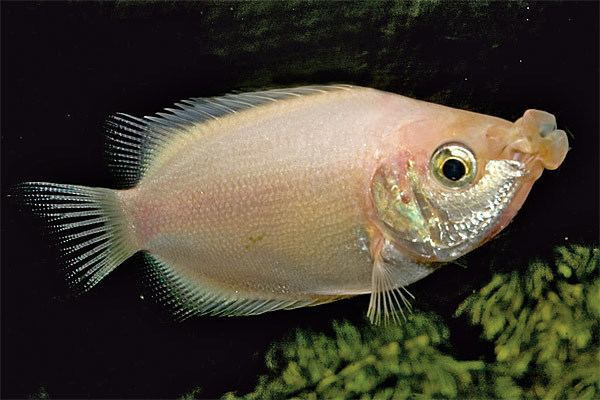 | ||
Family HelostomatidaeT. N. Gill, 1872 Genus HelostomaG. Cuvier, 1829 Similar Gourami, Pearl gourami, Three spot gourami, Dwarf gourami, Trichogaster | ||
Kissing gourami s kissing eachother
Kissing gouramis, also known as kissing fish or kissers (Helostoma temminckii), are large tropical freshwater fish comprising the monotypic labyrinth fish family Helostomatidae (from the Greek elos [stud, nail], stoma [mouth]). These fish originate from Thailand to Indonesia. They can be food fish which are farmed in their native Southeast Asia. They are used fresh for steaming, baking, broiling, and pan frying. The kissing gourami is a popular aquarium fish.
Contents
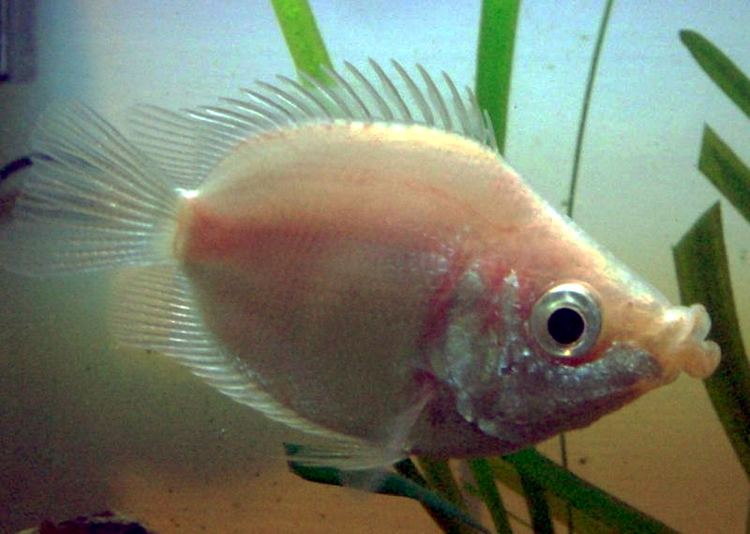
Description

Typical of gourami, the body is deep and strongly compressed laterally. The long-based dorsal (16–18 spinous rays, 13–16 soft) and anal fins (13–15 spinous rays, 17–19 soft) mirror each other in length and frame the body. The posterior most soft rays of each of these fins are slightly elongated to create a trailing margin. The foremost rays of the jugular pelvic fins are also slightly elongated. The pectoral fins are large, rounded, and low-slung. The caudal fin is rounded to concave. The lateral line is divided in two, with the posterior portion starting below the end of the other; there are a total of 43–48 scales running the line's length.
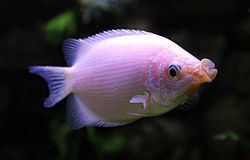
The most distinctive feature of the kissing gourami is its mouth. Other than being terminal (forward-facing) rather than superior (upward-facing) as in other gourami families, the kissing gourami's mouth is highly protrusible as its family name suggests, the lips are lined with horny teeth. However, teeth are absent from the premaxilla, dentaries, palatine, and pharynx. The gill rakers are also well-developed and numerous. The visible scales of the body are ctenoid, whereas the scales of the top of the head are cycloid. Kissing gourami reach a maximum of 30 cm (12 in) in total length. There is no outward sexual dimorphism and is difficult to almost impossible to distinguish the sexes.
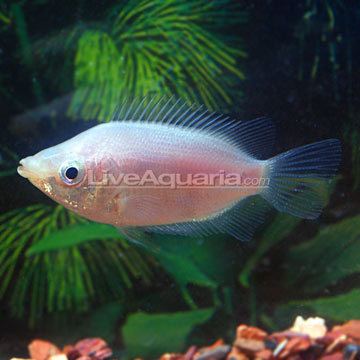
Two colour morphs are encountered: greens, which have lengthwise lateral stripes and opaque, dark brown fins; and pink, which have a rose to orangy pink body and silvery scales, with transparent pinkish fins. Green fish originate from Thailand, while pink fish originate from Java. There is also a "dwarf" or "balloon pink" variety, which is a mutated strain of the pink gourami that are offered to hobbyists. The "balloons" are named so for their smaller and rounder bodies.
Habitat and ecology
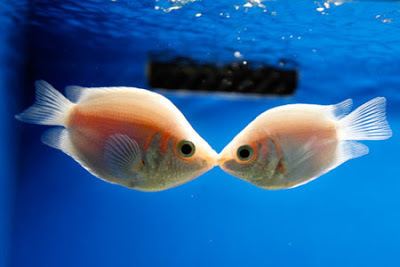
Shallow, slow-moving, and thickly vegetated backwaters are the kissing gourami's natural habitat. They are midwater omnivores that primarily graze on benthic algae and aquatic plants, with insects taken from the surface. They are also filter feeders, using their many gill rakers to supplement their diet with plankton. The fish use their toothed lips to rasp algae from stones and other surfaces. This rasping action, which (to humans) looks superficially like kissing, is also used by males to challenge the dominancy of conspecifics.
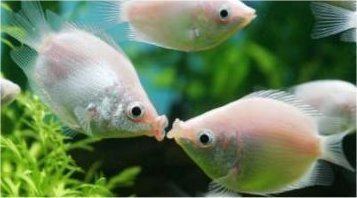
Spawning occurs from May to October in Thailand. Kissing gouramis are open-water egg scatterers; spawning is initiated by the female and takes place under cover of floating vegetation. The eggs, which the adults do not guard, are spherical, smooth, and buoyant. Initial development is rapid: the eggs hatch after one day, and the fry are free-swimming two days thereafter. The kissing gourami does not care for its young.
In the aquarium
Kissing gouramis are also popular with aquarists for the fish's peculiar "kissing" behavior of other fish, plants, and other objects. Kissers of both sexes will often spar by meeting mouths and pushing each other through the water. Large quantities of these fish are exported to Japan, Europe, North America, Australia, and other parts of the world for just this reason. Kissing gouramis need a roomy tank to thrive; they grow rapidly, and juvenile fish will quickly outgrow smaller aquaria. Kissing gouramis are territorial; some are tolerant towards fish of similar size, but others will bully, chase, and torment, causing significant stress on tank mates. Male kissers will occasionally challenge each other; however, the "kissing" itself is never fatal, but the constant bullying can stress the other fish to death. They often do in fact kill other fish by sucking the mucus off their skin as food, which opens the victim fish up to infections. These fish may be useful as algae eaters to control algae growth. To prevent digging and to present enough surface area for algae growth, the substrate should consist of large-diameter gravel and stones. The aquarium's back glass should not be cleaned during regular maintenance, as the gouramis will feed on the algae grown there. Most plants will not survive the fish's grazing, so inedible plants such as Java fern, Java moss, or plastic plants are recommended.
These fish are omnivorous and need both plant and animal matter in their diets. The fish will accept vegetables such as cooked lettuce and any kind of live food. Water hardness should be between 5 and 30 dGH and pH between 6.8 and 8.5; the temperature should be between 22 and 28 °C (72 and 82 °F). When breeding kissing gouramis, soft water is preferred. As the fish do not build nests, lettuce leaves placed on the water surface serve as a spawning medium. The lettuce will eventually host bacteria and infusoria upon which the fish will feed. The maximum length for kissing gouramis in aquariums is between 20 and 30 cm (8 and 12 in). Kissing Gourami are also a very long lived fish, a long term commitment for the fish keeper. They have been known to live in excess of 25 years (*).
